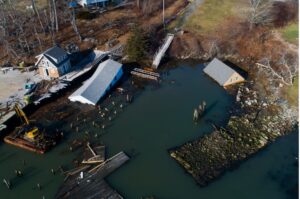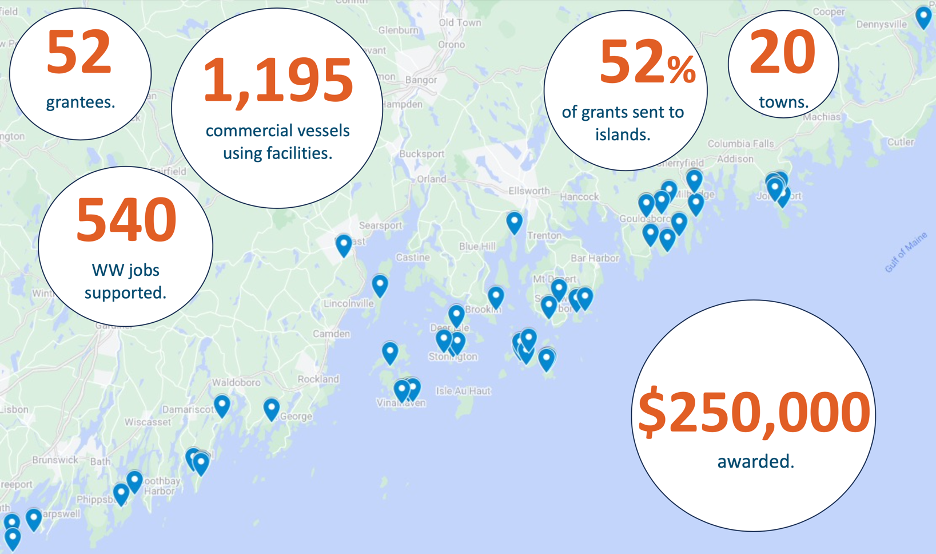As the tide surged and the winds howled last January, our coastal communities were unduly reminded of nature’s destructive power. The storms struck the coast – lifting wharves, eroding infrastructure, and bringing the livelihoods of many communities to a halt. In the aftermath, however, these storms have offered valuable lessons about how we can better protect and design our coastal infrastructure and storm response.
In the days after the storms, Island Institute staff were working to award $250,000 in storm response grants to 52 locations relied upon by nearly 1,200 commercial fishing vessels. The applications for funding we received offered a detailed account of the storm’s impact and the vulnerabilities of our working waterfronts.
At the same time, we saw communities, businesses, and policymakers springing into action around a shared goal: to rebuild stronger, more resilient, and better prepared for the future. As we move into another uncertain storm season, it’s a good time to reflect on a few lessons and observations from last winter’s storms.

The Importance of Timely Response
One of the immediate lessons was that our marine construction capacity to respond to large-scale damage was expectedly insufficient. Many of the wharves and marine facilities damaged in January faced timelines of 12 months or more before construction resources would become available. The unique logistical, environmental, safety, engineering, and equipment challenges of marine construction simply make repairing waterfronts at-scale an enormous challenge.
To potentially address these issues, we can look toward increasing our marine construction training and equipment capacity while also streamlining processes to ensure quicker responses after storm events. Emergency preparedness can be built into every level of planning, allowing for rapid mobilization of resources and personnel when disaster strikes.
Resilience Requires Long-Term Planning
While the immediate need to rebuild was undeniable, these storms also reminded us of the dangers of ad hoc infrastructure repairs. Many communities affected by the January storms were forced to quickly fix roads, ramps, and wharves just to make sure they could support enough fishing vessels to remain profitable in the upcoming season. The need to quickly rebuild can come at the expense of long-term resiliency; however, in the case of last January, if short-term repairs were not made, there may have been no need for some wharves to plan for the long-term at all.
Investing in resilient drainage systems, elevated foundations for critical infrastructure, breakwaters, revetments, and other flood barriers with the guidance of civil engineering experts can all help ensure that future construction is designed to withstand increasingly frequent and severe storm events.
Limited Support for Private Infrastructure
Maine’s working waterfronts are often privately owned, yet they are critical public infrastructure, providing access for commercial fishing and farming, marine transportation, and other community activities. Despite their importance, private owners of waterfront properties often lack the financial resources to make necessary resilience upgrades.
Maine has already made an important investment in building the resilience of privately owned working waterfronts. The Working Waterfront Resiliency Grant Program awarded $21.2 million in grant funding after the January storms to help working waterfronts damaged by the storms rebuild for greater resiliency. Additionally, Sen. Angus King has proposed providing a 30 percent tax credit on working waterfront infrastructure resilience projects which could help avoid more costly reactive rebuilding if passed into law.
These are important steps to consider as private flood insurance is often prohibitively expensive, leaving many wharf owners without adequate coverage. More than 30 other states offer publicly supported property insurance for high-risk homeowners. Assessing the effectiveness of those programs is important as the governor’s Infrastructure Rebuilding and Resilience Commission reviews various policy solutions for protecting our working waterfront.
Overall, it’s clear additional support is needed to help private wharf owners invest in the kind of resilient infrastructure that benefits their community at large. Public-private partnerships, tax incentives, and expanded grant programs are all avenues that can be explored to ensure that these critical community assets remain operational.
Resilience Through Diligence
While hearing from wharf owners throughout the summer, one of the key lessons is recognizing the penalty for ignoring regular maintenance and material upgrades. As with any business where upkeep of assets is essential to prevent larger and more costly failures, our working waterfronts require ongoing investment to remain resilient. And yet, while budgeting for routine preventative maintenance can be a powerful way to avoid major damage during severe storms, it is also one of the easiest costs to ignore on a year-to-year basis.
As we all know, small issues left unattended can become large over time. Weakened pilings, eroding bulkheads, aging dock materials can compound into unmanageable costs. Individual wharf owners, the communities that rely on marine infrastructure, and our state economy which banks on a thriving working waterfront can all help avoid the accumulation of deferred maintenance through financial assistance and incentives.

The Vulnerabilities (and Opportunities) of Consolidation
The economic realities of Maine’s working waterfronts, combined with the impact of these storms, mean that not all wharves will be rebuilt. By decision or default, some communities are consolidating operations toward fewer, more resilient wharves. While this aggregation may be financially pragmatic, it also introduces new vulnerabilities.
By concentrating more economic activity in fewer locations, we create points of potential failure that could lead to greater losses if those facilities are compromised in future storms. Be that as it may, aggregating financial interests among fewer working waterfront locations could also help disperse the costs of necessary resilient infrastructure measures if cooperative financial agreements can be established.
To mitigate risks and harness opportunities, the consolidation of our working waterfronts can be accompanied by robust infrastructure upgrades and collaborative planning among community stakeholders.
Data is Critical for Long-Term Planning
Another takeaway from the January storms is the need for better data and comprehensive mapping of Maine’s working waterfronts. As of now, we lack a complete and up-to-date inventory of the state’s coastal infrastructure – information that is essential for effective resilience planning.
By investing in data collection, we can better understand which areas are most vulnerable, what types of infrastructure are at risk, and where strategic investments can have the greatest impact. This will enable us to prioritize funding and resources, ensuring that we rebuild not only the waterfronts that were destroyed but also strengthen those that remain.
Looking Forward
While the damage from the January 2024 storms was devastating, it also represents a turning point. Maine’s coastal communities have shown their resilience in the face of adversity, and with the right investments, we can ensure that our working waterfronts are not only rebuilt but made stronger than ever.
At Island Institute, we are optimistic about what the future holds. We have already seen communities come together to repair, rebuild, and innovate. And with state and federal support, coupled with ingenuity and hard work, we can turn these lessons into actionable strategies that will safeguard our coast for future generations.
The challenges are large but so is our collective strength. Let’s seize this moment to ensure that our working waterfronts remain a vital part of our economy and culture, prepared for whatever the future may bring.


